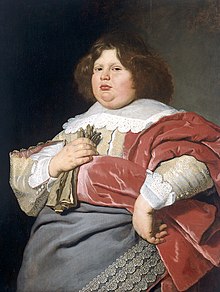Bartholomeus van der Helst
[2] Besides portraits, van der Helst painted a few genre pictures as well as some biblical scenes and mythological subjects.
Van der Helst had moved to Amsterdam some time before 1636, the year in which he married Anna du Pire, an 18-year-old woman from a prosperous family of the Southern Netherlands who was already orphaned.
The style of this painting suggests that in Amsterdam van der Helst may have trained with Nicolaes Eliaszoon Pickenoy.
[3] His first important commission was for a large schuttersstuk known as the Civic Guard led by Captain Roelof Bicker and Lieutenant Jan Michielsz.
The large 7.5m wide canvas was hung over the fireplace of the grand assembly of the Kloveniers guild, the same room for which Rembrandt painted The Night Watch.
[2] The city's military brass and wealthy members of the regent class all had portraits made by van der Helst.
[5][6] Van der Helst received a commission from the circle of the Stadtholder family, when he was asked in 1652 to paint the portrait of Mary, the widow of William II, Prince of Orange.
[8] He had no other known pupils but exerted an influence on Govert Flinck, Eustache Lesueur, Constantin Hansen, Alexander Sanders and Abraham van den Tempel.
According to the inventory he owned the schilder-boeck by Karel van Mander; Metamorphoses by Ovid; books by Serlio, Scamozzi, Vitruvius and Palladio; and portraits of Dutch admirals such as Egbert Bartholomeusz Kortenaer.
In addition to the portraits for which he is most famous, van der Helst painted a few genre, historical, biblical, mythological, and allegorical scenes.
The Portrait of Andries Bicker dated 1642 (Rijksmuseum, Amsterdam) is typical his work from this period: it is well modeled, of a strong plasticity and painted with a barely visible brush stroke.
The paintings of the final years of Van der Helst's career are characterized by increased attention to detail and a more even lighting.
[14] One of Van der Helst's most famous works is the portrait of Gerard Andriesz Bicker at half-length of 1639 (Rijksmuseum, Amsterdam).
At the time the painting was made Gerard Andriesz Bicker was only 20 years old, but already held the title of Lord of Engelenburg, an estate near Herwijnen belonging to the family.
The latter and former burgemeester Andries Bicker rallied the civic guard, hired 2,000 mercenaries, lifted the bridges, closed the gates and positioned the artillery.
An example of a genre scene by van der Helst is the View of the Nieuwmarkt (1638, Hermitage Museum, Saint Petersburg), which combines still life, cityscape and figure piece.
[4] Another genre scene is The Musician (1662, Metropolitan Museum of Art), which depicts a woman tuning a theorbo while a viola da gamba is resting in front of her.
[18] Van der Helst also collaborated with the animal painter Jan Baptist Weenix on the Shepherd boy with sheep and goats.
[19] Van der Helst's “Little Boy on His Deathbed,” was seized by Nazis during the German occupation of the Netherlands in World War II as part of their campaign to plunder Jewish assets.
The family of the Jewish Dutch art dealer Jacques Goudstikker won a restitution battle for the stolen painting fifty years later.






